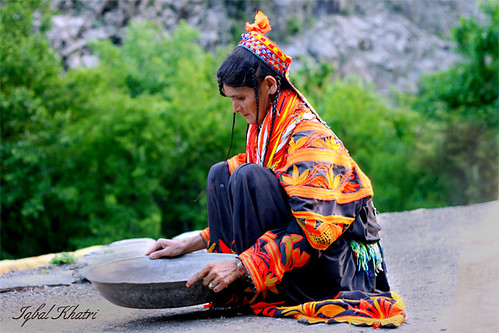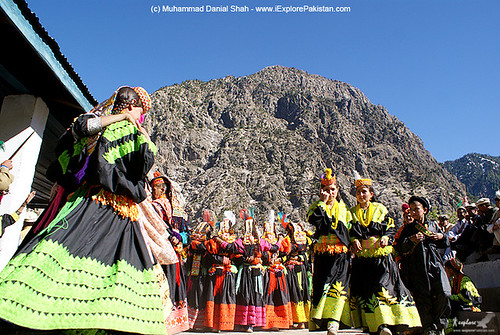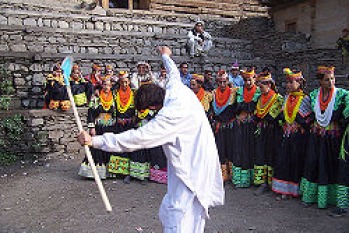Geographical Location:
35°42'18.30"N
71°41'52.73"E
Physical Location:
Northwest in the N.W.F.P province of Pakistan bordering Afghanistan in the Hindukush Range
Total Area:
Altitude:
Best Time to Visit:
May to October
The Kalash or Kalasha, are a Caucasoid ethnic group that lives in the Hindu Kush region of Pakistan. Located in the North-West Frontier Province of Pakistan, the Kalash people live in three isolated mountain valleys Bumboret, Rumbur and Birir.
Their neighbors, the Nuristani call them Kasivo. The Kalash are probably an ancient Dard people who speak the Kalasha-mun language. Many Kalash claim that they are the direct descendants of either Greek settlers, Alexander the Great's army, or even Alexander himself. The climate is typical of high elevation regions without large bodies of water to regulate the temperature. The summers are mild and agreeable with average maximum temperatures between 23° and 27°C Winters, on the other hand, can be very cold, with average minimum temperatures between 2° and 1°C. The average yearly precipitation is 700 to 800mm.
Culture;
The region is extremely fertile, covering the mountainside in rich oak forests and allowing for intensive agriculture, despite the fact that most of the work is done not by machinery, but by hand. The powerful and dangerous rivers that flow through the valleys have been harnessed to power grinding mills and to water the farm fields through the use of ingenious irrigation channels. Wheat, maize, grapes (generally used for wine), apples, and walnuts are among the many foodstuffs grown in the area, along with surplus fodder used for feeding the livestock.
Their unique culture and belief system differs drastically from the various ethnic groups surrounding them. The Kalash believe in various deities Mahadeo (Khodai, the Khowar word for God is also used), and worship other deities that offer protection to different aspects of life (such as Jeshtak, who represents family, pregnant mothers, and marriage). It is suggested that they are based on the Proto-Indo-European religion, similar to the twelve Olympian gods of Ancient Greece. Nature plays a highly significant and spiritual role in their daily life. As part of their religious tradition, sacrifices are offered and festivals held to give thanks for the abundant resources of their three valleys. Presently, these self-sufficient farmers are moving towards a cash-based economy whereas previously wealth was measured in livestock and crops.
They celebrate the Joshi (spring) festival at the end of May each year, which they gauged by the movement of the sun. The first day of Joshi is "Milk Day", on which the Kalash offer libations of milk that have been saved for ten days prior to the festival. Kalash women usually wear long black robes, often embroidered with cowries shells. Men have adopted the Pakistani shalwar kameez, while children wear small versions of adult clothing after the age of four.
In contrast to the surrounding Pakistani culture, the Kalash do not in general separate males and females or frown on contact between the sexes. However, menstruating girls and women are sent to live in the "bashaleni", the village menstrual building, during their periods, until they regain their "purity". They are also required to give birth in the bashaleni. There is also a ritual restoring "purity" to a woman after childbirth which must be performed before a woman can return to her husband. The husband is an active participant in this ritual. Kalash women breastfeed in public. Although some marriages are arranged by families, Kalash boys and girls can also propose and arrange their own marriages.
The Kalash have been ruled by the Mehtar of Chitral since the 1700s and have enjoyed a cordial relationship with the major ethnic group of Chitral, the Kho. The multi-ethnic and multi-religious State of Chitral ensured that the Kalash were able to live in peace and harmony and practice their culture and religion. The Nuristani, their neighbors in the region of former Kafiristan east of the border, were invaded in the 1890s and forced to convert to Islam by Amir Abdur-Rahman of Afghanistan and their land was renamed Nuristan.
Prior to that event, the people of Kafiristan had paid tribute to the Mehtar of Chitral and accepted his suzerainty. This came to an end with the Durand Agreement when Kafiristan fell under the Afghan sphere of Influence. Recently, the Kalash have been able to stop their demographic and cultural spiral towards extinction and have, for the past 30 years, been on the rebound. Increased international awareness, a more tolerant government, and monetary assistance has allowed them to continue their way of life.
Tourism now makes up a large portion of the economic activities of the Kalash. Before departing to the valleys one must first register one's name at the town of Chitral. People attempting to enter the valleys have to pay a toll to the Pakistani government, which they claim will be used to preserve and care for the Kalash people and their culture.
Travelers should refrain from interfering with or patronizing the locals. The villages are more heavily visited by tourists than ever before and the Holy festivals are very serious to them and joining in or gawking at their practices is considered very rude.
Famous festivals:
Joshi or Chilimjush :
14th and 15th of May. During this festival flowers are plucked, dance sessions are held and exchange of dairy products takes place.
Utchal:
Mid July. Celebrated to mark harvest season with dancing, singing and feasting for two days.
Phool:
20th to 25th September to celebrate the ripening of grapes and walnuts. They never touch grapes before this festival.
Chaumont:
Held in December from 15 to 21. This festival is celebrated with great pump and show on the onset of New Year. A number of interesting events mark this festival.
Mrachiwaki Joshi:
25 May Held ten days after the Joshi. After dividing and eating newly made cheese at the altar of Mahandeo, dances and songs continue.
Rat Nat :
July - August. Dancing and singing at night continue for one month.
Uchao:
Mid of August. Newly made cheese is brought from the pastures. Ceremony is held at the altar of Mahandeo. Dancing and singing take place until dawn.
Prechieishi:
November. Goats are sacrificed to Mahandeo by each clan in thanks for the harvest and health.
Biramor:
November.Very rare festival held only in November in which a man wishing to gain honour in the society slaughters many of his own goats and entertains a large majority of the Kalasha. It takes place once in several years.
Sariack:
November - December.Wedding party. She-goats are sacrificed to Jeshtak and prayers are offered for the couple. Dance and songs.
Pu and Budalak;
October. Festival only held in Biriu. Dancing and singing continue for three days. After Pu, grapes are allowed to be harvested. After that, a festival is held for the Budalak who returns from long stay in the pastures. He is a young goatherd who has some special sexual power and privileges.
Accessibility:
The journey from Islamabad and Peshawar to Kalash takes approximately 12-14 hours. It takes about 14-15 hours to reach Gilgit over Shandur Pass.
Pakistan International Airlines has a daily flight between Chitral and Peshawar International Airport. The flying time is approximately 50 minutes and the flight is scenic. These flights, however, are subject to the clearance of weather and in winters, flights are often delayed



















No comments:
Post a Comment